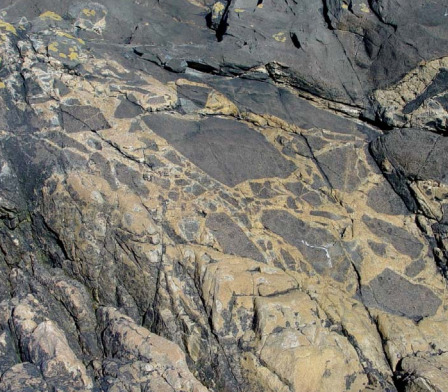
Cette cache n'est accessible que à marée basse
This cache is accessible only at low tide

click on the flag to reach the translation

Une Earthcache
Il ne s’agit pas d’une cache physique. Pour loguer cette cache, vous devez dans un premier temps prendre connaissance de sa description éducative en matière de géologie, puis d’observer le site sur lequel vous êtes, et enfin de répondre aux questions qui vous seront posées.
Vous pourrez alors loguer en "Found it" sans attendre mais vous devez me faire parvenir vos réponses en même temps en me contactant soit par mail dans mon profil, soit via la messagerie geocaching.com (Message Center), et je vous contacterai en cas de problème. Les logs enregistrés sans réponses seront supprimés.

Un peu de géologie
> Diorite
La diorite est une roche magmatique plutonique grenue composée de plagioclase, d'amphibole verte et de mica. Elle se distingue du gabbro par l'absence d'olivine, et du granite par son absence de quartz ou en quantité moindre en raison d'une richesse moins grande en silice.
Cette roche provient de magmas chimiquement intermédiaires entre les magmas granitiques et les magmas basaltiques, donnant par fusion partielle des roches appelées andésites quand elles sont volcaniques et diorites quand elles sont plutoniques.
> Pegmatite
La pegmatite (du grec pegma, « qui est assemblé, coagulé ») est une roche magmatique à grands cristaux (de taille supérieure à 1 cm, et pouvant atteindre plusieurs mètres), fréquemment automorphes - c’est-à-dire sous la forme d'un cristal parfait ou, au moins, limité par des faces cristallines planes.
On parle de phénocristal (du grec phainein, briller et cristal) pour un cristal d'une taille telle qu'il est visible à l'œil nu, d'un diamètre allant d'un millimètre à dix centimètres.
La plupart des roches à texture pegmatitique ont une composition voisine du granite, avec comme minéraux essentiels le quartz, des feldspaths et des micas (muscovite surtout) mais sont appauvries en minéraux mafiques (silicates riches en magnésium et fer) et enrichies en éléments incompatibles (concentration dans les liquides silicatés résiduels d’éléments normalement rares sur la planète).
Les pegmatites forment des filons (poches ou veines), en bordure ou au voisinage immédiat des plutons granitiques auxquels elles sont génétiquement associées. Elles correspondent généralement au liquide résiduel, riche en eau, de fin de cristallisation d'un magma granitique. L'abondance de l'eau facilite la diffusion des éléments chimiques et permet la croissance des grands cristaux.

association gabbro-diorite
> Pegmatitoïdes
L’association gabbro-diorite crée des structures étonnantes et différentes, dont les principales sont les faciès anguleux à grands cristaux (photo). Voir earthcache Faciès magmatiques (GC9B4H3) .
Mais le site de Trégastel-Primel en accueille une toute particulière : les pegmatides gabbroïques, ou encore pegmatitoïdes. Il s’agit d’un gabbro aux cristaux géants pluricentimétriques, dont la présence n'est pas facile à expliquer. Si ces roches s'étaient formées en fin de cristallisation dans la partie supérieure de la chambre magmatique, elles auraient dû avoir une composition plus acide provenant d'un jus plus différencié. Leur mise en place est peut être plus précoce. La grande taille des cristaux peut aussi s'expliquer par une teneur en eau plus importante du magma.

Questions
Question 0 - Prenez une photo de vous, ou de votre objet distinctif de géocacheur, ou de votre pseudo écrit sur une feuille de papier ou dans votre main... sur le front de mer de la plage de Trégastel, et joignez-là à votre log ou à vos réponses

Zone d'observation - Avancez au milieu de la plage jusqu’à atteindre les petits rochers en forme de « crocodile ». Vous observerez 2 rochers de gabbro de part et d’autre du rocher principal de granite rose

Face avant du rocher A
Question 1 - Décrivez cette face et ce que vous y voyez, incluant forme, couleur et taille
Question 2 - Quel est le nom de cette structure gabro-dioritique ?

Face arrière du rocher A
Question 3 - Décrivez cette face et ce que vous y voyez, incluant forme, couleur et taille
Question 4 - Quel est le nom de ce phénomène ?

Rocher B
Question 5 - Quelle est la différence singulière entre les 2 parties du rocher
Question 6 - Dans quelle position de ces 2 parties peut-on penser que la roche s’est formée ?


An Earthcache
It is not a physical cache. To log this cache, you must first learn about its educational description in geology, then observe the site on which you are, and finally answer the questions that will be asked.
You can then log in "Found it" without waiting but you must send me your answers at the same time by contacting me either by mail in my profile, or via the messaging geocaching.com (Message Center), and I will contact you in case of problem. Saved logs without answers will be deleted.

A little of geology
> Diorite
Diorite is a grainy plutonic igneous rock composed of plagioclase, green amphibole and mica. It is distinguished from gabbro by the absence of olivine, and from granite by its absence of quartz or in less quantity due to a lower richness in silica.
This rock comes from magmas chemically intermediate between granitic magmas and basaltic magmas, giving by partial fusion rocks called andesites when they are volcanic and diorites when they are plutonic.
> Pegmatite
Pegmatite (from the Greek pegma, “which is assembled, coagulated”) is a igneous rock with large crystals (larger than 1 cm in size, and up to several meters), frequently automorphic - that is to say in the form of a perfect crystal or, at least, limited by plane crystal faces.
We speak of phenocryst (from the Greek phainein, to shine and crystal) for a crystal of a size such that it is visible to the naked eye, with a diameter ranging from one millimeter to ten centimeters.
Most pegmatitic-textured rocks have a composition similar to granite, with quartz, feldspars and micas (especially muscovite) as essential minerals, but are depleted in mafic minerals (silicates rich in magnesium and iron) and enriched in incompatible elements (concentration in residual silicate liquids of elements normally rare on the planet).
The pegmatites form veins (pockets or veins), on the edge of or in the immediate vicinity of the granite plutons with which they are genetically associated. They generally correspond to the residual liquid, rich in water, at the end of crystallization of a granitic magma. The abundance of water facilitates the diffusion of chemical elements and allows the growth of large crystals.

association gabbro-diorite
> Pegmatitoïdes
The gabbro-diorite association creates amazing and different structures, the main ones being the angular large crystal facies (photo). See earthcache Faciès magmatiques (GC9B4H3).
But the Trégastel-Primel site hosts a very special one: gabbroic pegmatids, or even pegmatitoids. It is a gabbro with giant pluricentimetric crystals, the presence of which is not easy to explain. If these rocks had formed at the end of crystallization in the upper part of the magma chamber, they should have had a more acidic composition coming from a more differentiated juice. They may be put in place earlier. The large size of the crystals can also be explained by a higher water content of the magma.

Questions
Question 0 - Take a picture of yourself, or your geocacher signature, or your nickname written on a piece of paper or in your hand ... on sea front at Tregastel beach, and attach it to your log or answers

Zone d'observation - Walk through the middle of the beach until you reach the small "crocodile" shaped rocks. You will observe 2 gabbro rocks on either side of the main pink granite rock

Rock A (front face)
Question 1 - Describe this face and what you see on it, including shape, color and size
Question 2 - What is the name of this gabro-dioritic structure ?

Rock A (back)
Question 3 - Describe this face and what you see on it, including shape, color and size
Question 4 - What is the name of the phenomenon?

Rock B
Question 5 - What is the singular difference between the 2 parts of the rock
Question 6 - In what position of these 2 parts can we think that the rock was formed?